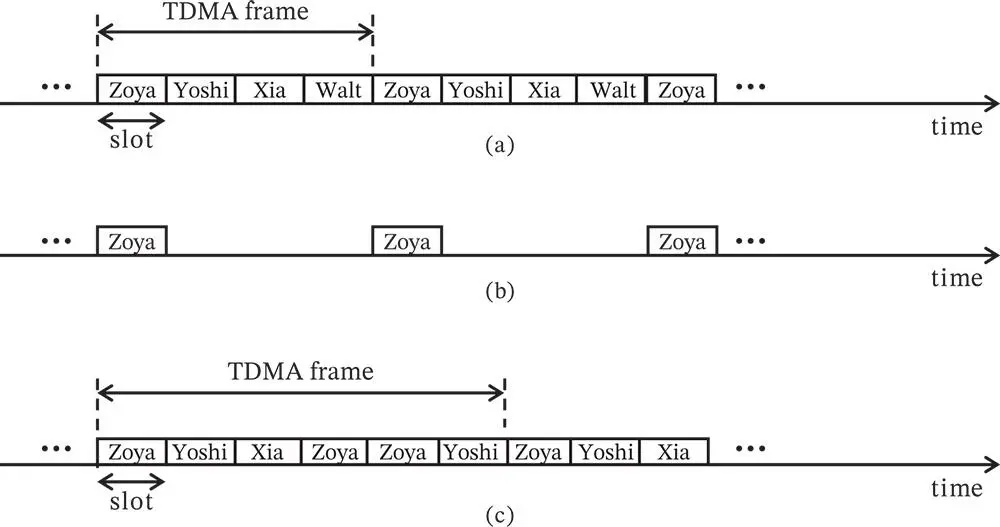1 ...6 7 8 10 11 12 ...27 Through the problem of first contact and link establishment, we have introduced randomization as the key idea used in breaking the symmetry among different wireless devices that want to access the same shared medium. In the next chapter we will see that randomization can also be useful for efficient medium access after the links have been initially established.
1.2.3 Rendezvous with Full-Duplex Devices
The problem of first contact becomes easier if the mobile devices are equipped with full-duplex capability. If Zoya and Yoshi both transmit simultaneously an invite packet to each other, then each of them will simultaneously receive the invite packet from the other device. Furthermore, in the next slot both Zoya and Yoshi transmit an invitation_accepted packet and, again, Zoya receives this packet from Yoshi and vice versa. With this, the link can be considered as being established. Therefore, full-duplex avoids the need for randomized assignment of transmit/receive roles and thus speeds up the procedure of link establishment. This may appear to be one of the most important advantages of full-duplex technology in scenarios in which fast link establishment and device discovery is of high importance.
We note that, even with full-duplex, there is still the problem of interference due to collision. Hence, full-duplex cannot help to solve the problem of colliding invite packets in Figure 1.3, as Zoya still does not get either of the two invite packets.
1.3 Multiple Access with Centralized Control
Referring again to Figure 1.2, let us assume that each of the mobile devices has established a link with Basil and we turn to the problem of actual data communication. Since in some examples we have to refer to a set of  mobile devices or terminals connected to the same base station, we will also use depersonalized identification of the mobile devices
mobile devices or terminals connected to the same base station, we will also use depersonalized identification of the mobile devices  interchangeably. Here it will be understood that Zoya uses
interchangeably. Here it will be understood that Zoya uses  , Yoshi uses
, Yoshi uses  , etc. The objective of this section is to bring the reader to a simple, but functional design of a wireless system that can establish/disconnect links and exchange data between the devices and a base station Basil that acts as a central controller.
, etc. The objective of this section is to bring the reader to a simple, but functional design of a wireless system that can establish/disconnect links and exchange data between the devices and a base station Basil that acts as a central controller.
1.3.1 A Frame for Time Division
Let us first consider downlink traffic, such that Basil has data to transmit to each of the devices. Then a straightforward idea is the one in which Basil divides the time into slots, where each slot has a duration of  , which corresponds to the duration of the transmission of a single packet. In each slot, Basil can send a single packet to a particular device. For the moment we are ignoring the possibility that Basil can broadcast a common packet to all devices, using the shared property of the wireless medium. Keep in mind that we are still assuming that all packets have the same size. This mode of communication is a simple variant of time division multiple access (TDMA) : at a given time, the whole shared medium is allocated to a single user, that is, the terminal to which Basil transmits. The simplest TDMA scheme with
, which corresponds to the duration of the transmission of a single packet. In each slot, Basil can send a single packet to a particular device. For the moment we are ignoring the possibility that Basil can broadcast a common packet to all devices, using the shared property of the wireless medium. Keep in mind that we are still assuming that all packets have the same size. This mode of communication is a simple variant of time division multiple access (TDMA) : at a given time, the whole shared medium is allocated to a single user, that is, the terminal to which Basil transmits. The simplest TDMA scheme with  users is depicted in Figure 1.5(a), where each device gets an equal fraction
users is depicted in Figure 1.5(a), where each device gets an equal fraction  of the shared channel. It is convenient to define a TDMA frame , which is periodically repeated, and see how one can define a logical channel by using the physical, shared communication channel. For the example in Figure 1.5(a), the logical communication channel between Basil and Zoya is the first slot in each TDMA frame, as depicted in Figure 1.5(b). The data rate of the logical channel is easily calculated as follows. The data rate of each packet is
of the shared channel. It is convenient to define a TDMA frame , which is periodically repeated, and see how one can define a logical channel by using the physical, shared communication channel. For the example in Figure 1.5(a), the logical communication channel between Basil and Zoya is the first slot in each TDMA frame, as depicted in Figure 1.5(b). The data rate of the logical channel is easily calculated as follows. The data rate of each packet is  , such that in each frame a total of
, such that in each frame a total of  bits are sent to Zoya. If
bits are sent to Zoya. If  frames are observed, Zoya receives in total
frames are observed, Zoya receives in total  bits over a duration of
bits over a duration of  s, which makes the equivalent data rate for Zoya
s, which makes the equivalent data rate for Zoya
(1.1) 
 Figure 1.5 Downlink time division multiple access (TDMA). (a) Periodic equal allocation to all terminals. (b) The downlink communication channel from the perspective of Zoya. (c) Periodic allocation, but unequal across the terminals.
Figure 1.5 Downlink time division multiple access (TDMA). (a) Periodic equal allocation to all terminals. (b) The downlink communication channel from the perspective of Zoya. (c) Periodic allocation, but unequal across the terminals.
This very simple fact is, surprisingly, often neglected in practice. For example, a wireless system may have a nominal speed of, e.g.,  (Mbps, megabits per second), but this data speed is rather instantaneous and valid during the times when the user receives the data. However, if a lot of data needs to be sent by the user over a long period, then the average data rate is decreased because there are time intervals in which no data is sent to the user and thus their data rate in those time intervals is strictly zero. This leads to the conclusion that, for a consistent definition, we should always keep in mind that there is a particular time interval
(Mbps, megabits per second), but this data speed is rather instantaneous and valid during the times when the user receives the data. However, if a lot of data needs to be sent by the user over a long period, then the average data rate is decreased because there are time intervals in which no data is sent to the user and thus their data rate in those time intervals is strictly zero. This leads to the conclusion that, for a consistent definition, we should always keep in mind that there is a particular time interval  over which the data rate is calculated:
over which the data rate is calculated:
(1.2) 
Most of the time  is implicitly clear from the context.
is implicitly clear from the context.
If Basil is certain in advance that sending  bits each
bits each  s is sufficient for each terminal, then the simple TDMA is an easy and, in fact, perfect solution. In addition, the frame structure can be established once and kept indefinitely, as long as the devices stay synchronized to the frame defined by Basil. This is the essence of a circuit-switched connection in communications, where the usage of a certain communication resource is agreed in advance for a long period of time. In this particular example, Basil may have agreed with the mobile devices in the past that Zoya will use the first slot in a frame, Yoshi the second, etc. This means that whenever the time slot allocated to Zoya comes, Basil does not need to use a part of the
s is sufficient for each terminal, then the simple TDMA is an easy and, in fact, perfect solution. In addition, the frame structure can be established once and kept indefinitely, as long as the devices stay synchronized to the frame defined by Basil. This is the essence of a circuit-switched connection in communications, where the usage of a certain communication resource is agreed in advance for a long period of time. In this particular example, Basil may have agreed with the mobile devices in the past that Zoya will use the first slot in a frame, Yoshi the second, etc. This means that whenever the time slot allocated to Zoya comes, Basil does not need to use a part of the  bits to send signaling information and thus label the packet “This packet is for Zoya” . Instead, it is sufficient to send pure data to Zoya as every other device in the network knows that what is being sent in that slot is data for Zoya.
bits to send signaling information and thus label the packet “This packet is for Zoya” . Instead, it is sufficient to send pure data to Zoya as every other device in the network knows that what is being sent in that slot is data for Zoya.
Читать дальше

 mobile devices or terminals connected to the same base station, we will also use depersonalized identification of the mobile devices
mobile devices or terminals connected to the same base station, we will also use depersonalized identification of the mobile devices  interchangeably. Here it will be understood that Zoya uses
interchangeably. Here it will be understood that Zoya uses  , Yoshi uses
, Yoshi uses  , etc. The objective of this section is to bring the reader to a simple, but functional design of a wireless system that can establish/disconnect links and exchange data between the devices and a base station Basil that acts as a central controller.
, etc. The objective of this section is to bring the reader to a simple, but functional design of a wireless system that can establish/disconnect links and exchange data between the devices and a base station Basil that acts as a central controller. , which corresponds to the duration of the transmission of a single packet. In each slot, Basil can send a single packet to a particular device. For the moment we are ignoring the possibility that Basil can broadcast a common packet to all devices, using the shared property of the wireless medium. Keep in mind that we are still assuming that all packets have the same size. This mode of communication is a simple variant of time division multiple access (TDMA) : at a given time, the whole shared medium is allocated to a single user, that is, the terminal to which Basil transmits. The simplest TDMA scheme with
, which corresponds to the duration of the transmission of a single packet. In each slot, Basil can send a single packet to a particular device. For the moment we are ignoring the possibility that Basil can broadcast a common packet to all devices, using the shared property of the wireless medium. Keep in mind that we are still assuming that all packets have the same size. This mode of communication is a simple variant of time division multiple access (TDMA) : at a given time, the whole shared medium is allocated to a single user, that is, the terminal to which Basil transmits. The simplest TDMA scheme with  users is depicted in Figure 1.5(a), where each device gets an equal fraction
users is depicted in Figure 1.5(a), where each device gets an equal fraction  of the shared channel. It is convenient to define a TDMA frame , which is periodically repeated, and see how one can define a logical channel by using the physical, shared communication channel. For the example in Figure 1.5(a), the logical communication channel between Basil and Zoya is the first slot in each TDMA frame, as depicted in Figure 1.5(b). The data rate of the logical channel is easily calculated as follows. The data rate of each packet is
of the shared channel. It is convenient to define a TDMA frame , which is periodically repeated, and see how one can define a logical channel by using the physical, shared communication channel. For the example in Figure 1.5(a), the logical communication channel between Basil and Zoya is the first slot in each TDMA frame, as depicted in Figure 1.5(b). The data rate of the logical channel is easily calculated as follows. The data rate of each packet is  , such that in each frame a total of
, such that in each frame a total of  bits are sent to Zoya. If
bits are sent to Zoya. If  frames are observed, Zoya receives in total
frames are observed, Zoya receives in total  bits over a duration of
bits over a duration of  s, which makes the equivalent data rate for Zoya
s, which makes the equivalent data rate for Zoya
 Figure 1.5 Downlink time division multiple access (TDMA). (a) Periodic equal allocation to all terminals. (b) The downlink communication channel from the perspective of Zoya. (c) Periodic allocation, but unequal across the terminals.
Figure 1.5 Downlink time division multiple access (TDMA). (a) Periodic equal allocation to all terminals. (b) The downlink communication channel from the perspective of Zoya. (c) Periodic allocation, but unequal across the terminals. (Mbps, megabits per second), but this data speed is rather instantaneous and valid during the times when the user receives the data. However, if a lot of data needs to be sent by the user over a long period, then the average data rate is decreased because there are time intervals in which no data is sent to the user and thus their data rate in those time intervals is strictly zero. This leads to the conclusion that, for a consistent definition, we should always keep in mind that there is a particular time interval
(Mbps, megabits per second), but this data speed is rather instantaneous and valid during the times when the user receives the data. However, if a lot of data needs to be sent by the user over a long period, then the average data rate is decreased because there are time intervals in which no data is sent to the user and thus their data rate in those time intervals is strictly zero. This leads to the conclusion that, for a consistent definition, we should always keep in mind that there is a particular time interval  over which the data rate is calculated:
over which the data rate is calculated:
 is implicitly clear from the context.
is implicitly clear from the context. bits each
bits each  s is sufficient for each terminal, then the simple TDMA is an easy and, in fact, perfect solution. In addition, the frame structure can be established once and kept indefinitely, as long as the devices stay synchronized to the frame defined by Basil. This is the essence of a circuit-switched connection in communications, where the usage of a certain communication resource is agreed in advance for a long period of time. In this particular example, Basil may have agreed with the mobile devices in the past that Zoya will use the first slot in a frame, Yoshi the second, etc. This means that whenever the time slot allocated to Zoya comes, Basil does not need to use a part of the
s is sufficient for each terminal, then the simple TDMA is an easy and, in fact, perfect solution. In addition, the frame structure can be established once and kept indefinitely, as long as the devices stay synchronized to the frame defined by Basil. This is the essence of a circuit-switched connection in communications, where the usage of a certain communication resource is agreed in advance for a long period of time. In this particular example, Basil may have agreed with the mobile devices in the past that Zoya will use the first slot in a frame, Yoshi the second, etc. This means that whenever the time slot allocated to Zoya comes, Basil does not need to use a part of the  bits to send signaling information and thus label the packet “This packet is for Zoya” . Instead, it is sufficient to send pure data to Zoya as every other device in the network knows that what is being sent in that slot is data for Zoya.
bits to send signaling information and thus label the packet “This packet is for Zoya” . Instead, it is sufficient to send pure data to Zoya as every other device in the network knows that what is being sent in that slot is data for Zoya.










